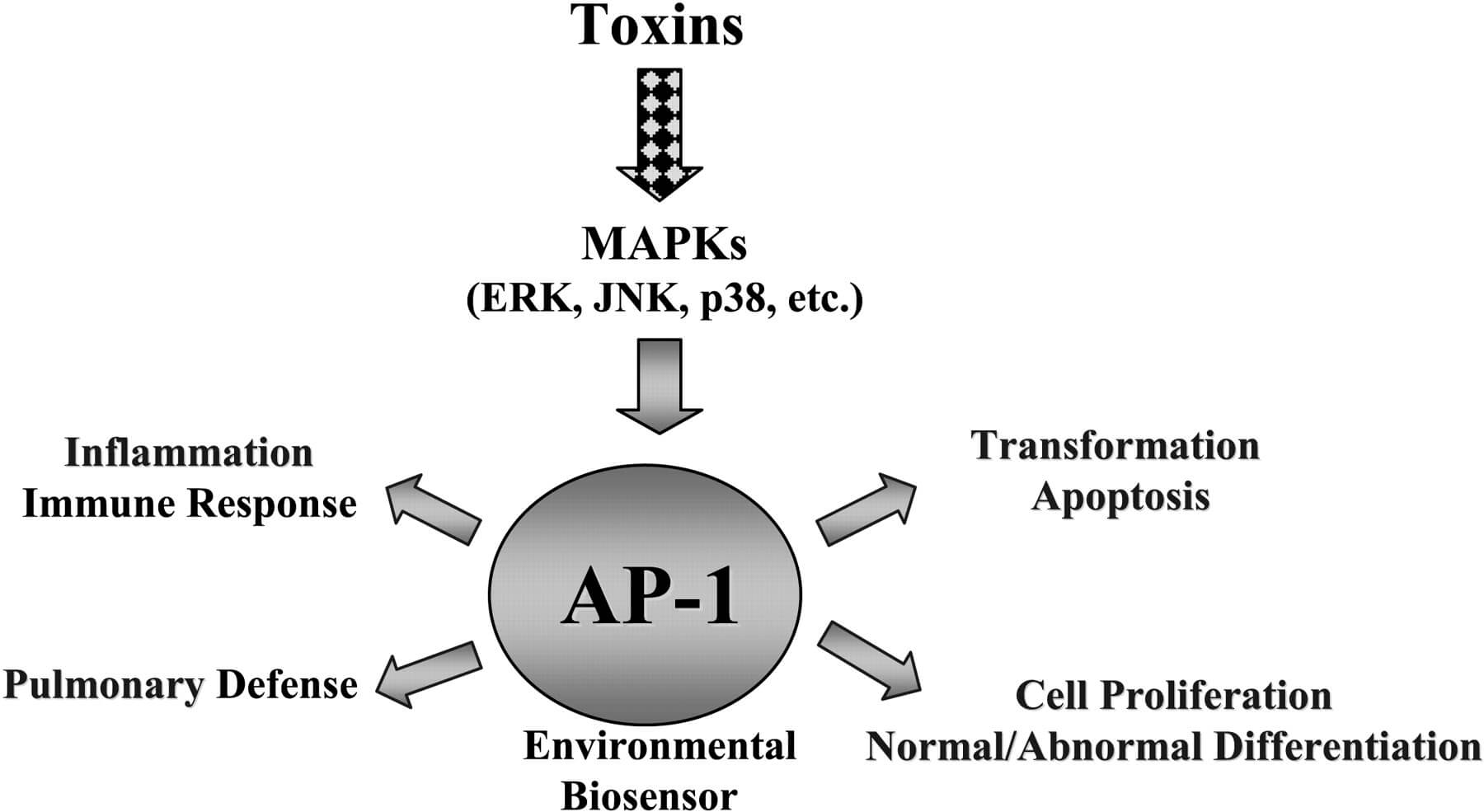
AP-1 (Activating protein-1) is a transcription factor that controls various cellular processes including differentiation, proliferation, and apoptosis. These proteins were primarily considered as oncogenic, but recent studies have challenged this view. Continue to read to know more about the various effects of AP-1 on cancer and other factors in human health.
What is Activating Protein-1?
AP-1 stands for activating protein-1. It is a transcription comprised of the sub-units Jun (c-jun, junB, junD), Fos (c-fos, fra-1, fra-2), or ATF (activating transcription factor).
They bind to a common DNA site, which is referred to as an AP-1 binding site.
Gene knockout mice studies have helped scientists understand the complexity of these factors and that AP-1 can control different genes and perform specific biological functions.
It also coordinates cellular processes like cell increase (proliferation) and survival, growth, production, cell death (apoptosis), cell movement (migration), and transformation [1, 2].
AP-1 causes cell growth, including in hematopoietic and neuronal cells.
Effects of AP-1 on Human Health
1) Cancer
Breast
By blocking the AP-1 complex, multiple growth signals that cause breast cell proliferation and transformation may be restrained.
To increase breast cancer cells, there need to be signals from specific growth factors like estrogen, peptide growth factors, epidermal growth factor (EGF), transforming growth factor α (TGFα), interleukins, hematopoietic cytokines, and heregulin and insulin-like growth factors (IGFs).
All these elements stimulate an increase in the activity of this transcription factor in different ways.
The AP-1 blockade restrains cell cycle division during the first stage of the cell cycle (G1 phase).
It also restrains the signals that cause breast cell overproduction by causing a cell cycle blockade in Activating Protein transcription factors.
This is extremely important because many breast cancer cells become resistant to anti-estrogen treatments, and understanding other targets for breast cancer can help researchers identify other chemopreventive and chemotherapeutic strategies [3, 4].
Cervical
AP-1 plays a major role in the HPV,
During the binding activity of AP-1, c-fos expression highly increased and Fra-1 expression decreased in relation to the increasing severity of the cervical lesions.
As the disease severity became invasive, Fras-1 decreased to nearly zero. JunB is another subunit of Activating Protein-1 that is involved with the DNA binding activity, and it has higher levels within carcinoma cells (5, 6).
Skin
AP-1 expression and activity correlate with different changes in the development and progression stages of melanoma.
AP-1 also contributes to the malignancy of epidermal cells.
Studies found AP-1 binding and transactivating ability in malignant cells [7].
2) Bones
The Fos subunit of AP-1 is a major contributor to bone development. C-fos is a differentiation-specific transcription factor for cells that resorb bone tissue (osteoclasts).
3) Wound Healing
AP-1 moderates gene management in response to extracellular stimuli like growth factors, cytokines, oncogenes, tumor promoters, and chemical cancer.
Sub-units of this transcription factor have various contributing factors to different layers of skin.
These expressions of AP-1 subunits indicates that the proteins are associated with cells of the epidermis that make keratin (keratinocyte). Keratin is extremely important because it is the main component of the epidermis, nails, and teeth.
AP-1 functioning is necessary for situations that require a rapid and temporary balance of keratinocyte multiplication and production.
Therefore, Activating Protein-1 functioning benefits skin (cutaneous) wound healing. This is by regulating the creation of regulatory proteins released by the immune system (cytokines) and cell growth factors [6].
4) Photoaging
The process of premature aging caused by ultraviolet rays (photoaging) involves the induction of AP-1 regulated matrix metalloproteinases (MMP).
MMP’s also increased due to UV radiation exposure (irradiation) [6].
Overexposure to ultraviolet radiation on the skin can have numerous adverse effects on the body like oxidative stress, and inflammation.
Thyme vulgaris protected mice against ultraviolet rays that burn and damage the epidermis (UVB).
It did so by reducing the activation and deactivation of AP-1 signaling pathways in normal human dermal connective tissue [8].
5) Regulates Inflammatory Skin Disease
AP-1 regulates inflammation by p65/NF-kB-dependent and -independent inflammatory mediators.
The reduction or imbalance of JunB and c-Jun can cause skin diseases like psoriasis, lichen planus, and dermatofibrosis.
A reduction in the binding activity of this transcription factor was also found in lesions caused by psoriasis. The modulation of Jun in keratinocytes can trigger an oversupply of chemokine/cytokine.
This causes the selection of white blood cells and macrophages directed towards the epidermis. This process contributes to the changes necessary for psoriasis to occur [9, 10].
6) Atherosclerosis
AP-1 transmission pathways are involved in the initiation of atherosclerosis.
Studies show that AP-1 increases during the development of progressive and non-progressive atherosclerosis, but is absent in the subsequent progressive stages of the disease.
Doxycycline, an anti-inflammatory and immunomodulating agent, was tested on patients with atherosclerosis in arteries of the extremities (peripheral artery disease, PAD).
In cells, Doxycycline was proven to be an effective selective inhibitor of this transcription factor and is comparable to SP600125 [11].
7) Rheumatoid Arthritis
Curcumin, the main component of turmeric, has anti-inflammatory and anti-arthritic characteristics.
Studies conducted on rheumatoid arthritis patients concluded that curcumin administered in a dose-dependent manner can reduce bone reduction (osteoclastogenesis).
Curcumin can be beneficial to degenerative bones disorders like osteoporosis and rheumatoid arthritis by targeting AP-1 pathways [12].
AP-1 and other inflammatory transcription factors can be repressed by glucocorticoids.
This suppresses the pro-inflammatory characteristics of the Activating Protein, thus preventing autoimmune diseases like rheumatoid arthritis [13].
8) Ulcerative Colitis
Ulcerative colitis (UC) is an inflammatory bowel disease (IBD), which is a spontaneous (idiopathic), chronic, and recurrent inflammatory condition in the gastrointestinal tract.
Studies performed on mice found that inhibiting AP-1 can protect against drug-induced colitis [14].
AP-1 inhibitors
- Resveratrol
- Curcumin [15, 16]
- Quercetin [17]
- Chlorogenic acid [18]
- Anthocyanins (from red raspberries) [19]
- Honokiol [20]
- Pycnogenol [21]
- Apigenin [22]
- Andrographis [23]
- Astragalus/Astragaloside IV [24]
- Kaempferol [25]
- Naringenin [26]
- Licorice/LicoA [27]

